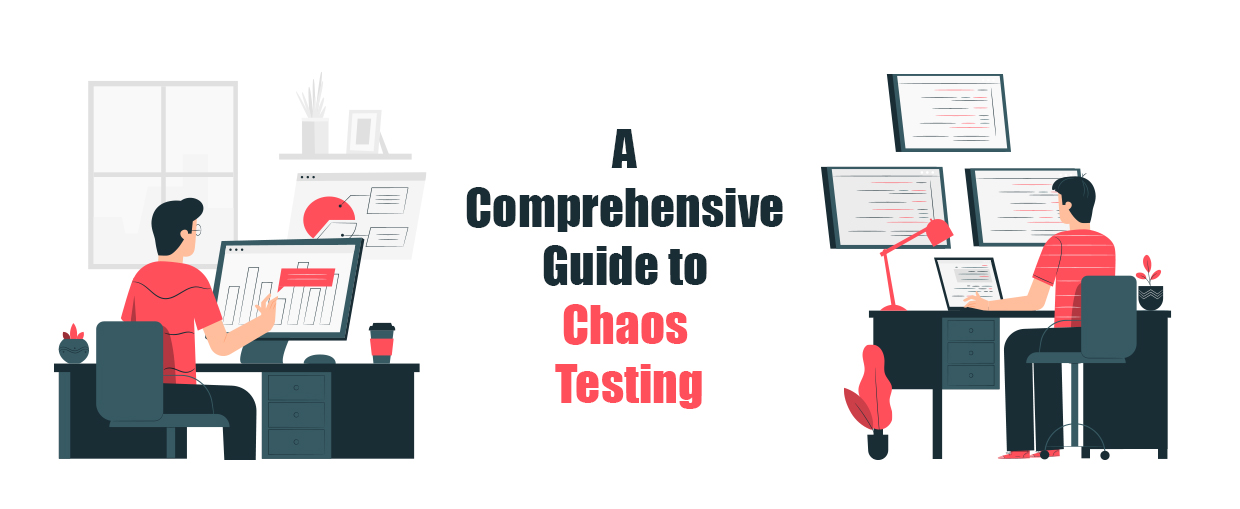In today’s fast-paced world of technology, ensuring system resilience and reliability is more crucial than ever. As software applications grow more complex, the chances of failure increase, making it essential for businesses to adopt advanced testing methodologies. Chaos testing—a strategic approach to testing system resiliency by simulating failures—has become a game-changer in this regard. By running chaos tests in a production environment, IT and DevOps teams can see how their software responds to different real-world stresses, allowing them to catch potential issues before they impact users.
A software development company providing comprehensive IT consulting services can effectively utilize chaos testing to ensure that the applications they develop are robust enough to handle real-world challenges. In this blog, we’ll we will walk you through all the fundamentals of chaos testing, covering its definition, key principles, methodology, challenges, and best practices.
What is Chaos Testing?
A primary function of chaos engineering, chaos testing was pioneered by Netflix in 2010 during their transition to Amazon Web Services. This modern DevOps practice employs unexpected and random conditions, actions, and failures to assess the resilience of a software product or system.
During chaos testing, testers intentionally inject failures and faults into a system’s infrastructure to evaluate its response. When conducted in a controlled manner, this approach effectively prepares teams to minimize and prevent outages and downtime before they occur. In essence, chaos testing involves deliberately inducing failures in a production system to observe how the application reacts under stress.
What Sets Chaos Testing Apart from Regular Testing Practices?
Chaos testing significantly differs from standard testing in several ways. While standard testing focuses on specific touchpoints within a predetermined scope, chaos testing examines various factors beyond these limits, assessing how a system reacts to unexpected scenarios. Regular testing occurs during the build or compile phases, whereas chaos testing is conducted after the system is fully developed. Unlike standard testing, which often overlooks varying configurations and external interruptions, chaos testing actively simulates these conditions.
Additionally, while traditional testing addresses straightforward issues leading to negative user experiences, chaos testing intentionally injects faults to evaluate system resilience. Moreover, chaos testing employs a predetermined abort strategy, allowing controlled failures and facilitating learning from unexpected outcomes.
Fundamental Principles of Chaos Testing
By adhering to the principles given below, software development teams can enhance their app development services and ensure a more resilient and reliable end product.
Specify the System’s Expected Behavior
Testers can establish the steady state of a system using measurable outputs, such as system latency, error rates, and throughput. This steady state should reflect the system’s normal behavior—what is considered acceptable performance—rather than any unexpected fluctuations. Essentially, the normal system state should be regarded as its steady state.
Formulate a Hypothesis
This principle focuses on creating a steady state hypothesis that reflects the expected outcomes of the experiment. Essentially, this hypothesis should support the main goal of chaos engineering: to ensure that the events we introduce into the system do not push it out of its steady state. In other words, the system should remain stable and operate normally, even when faced with these injected failures.
Design and Execute Experiments
This principle involves designing failure scenarios within the system’s infrastructure and executing them in a controlled manner. Testers should ensure that there is a clear recovery plan or a fallback strategy in place to address any issues that may arise during the experiments.
Analyze Test Results
This principle focuses on verifying the accuracy of the hypothesis and assessing whether the system’s steady state has been affected by discrepancies in user experience or server performance.
Performing Chaos Testing: A Step-by-Step Approach
Chaos testing involves introducing unexpected scenarios to evaluate system behavior, making it an experimental approach. The primary steps typically followed in any experiment are also applicable to chaos testing:
Define Objectives: Clearly outline what you intend to test and establish the expected steady-state behavior of your system.
Hypothesis Planning: Formulate hypotheses about the expected outcomes when specific failures are introduced into the system.
Choose Targets: Identify and select the specific components of your system that will be tested.
Inject Failures: Introduce faults into the system by terminating processes, simulating network failures, or applying resource constraints.
Monitor Results: Carefully observe the system’s response, focusing on its recovery time and overall resilience.
Evaluate Results: Assess the actual behavior of the system against the expected outcomes and pinpoint areas for improvement.
Iterate: Using the analysis results, implement improvements and repeat the process to continually strengthen the system.
Chaos Testing Pyramid
The chaos testing pyramid is a structured framework for implementing chaos testing at various levels of system complexity. At the base of the pyramid is unit testing, which concentrates on individual components to assess their specific behaviors in failure scenarios. The next level is integration testing, which examines the interactions between components to ensure seamless functioning across interfaces. At the top of the pyramid is system testing, where the entire system is evaluated by simulating real-world chaotic conditions to observe its behavior and response under stress. This tiered approach ensures a balanced focus on testing efforts and outcomes.
Key Tools for Chaos Testing
To enhance the chaos testing process, several automated tools have been developed. Notable examples include:
Chaos Monkey: This pioneering chaos testing tool randomly shuts down virtual machines and containers to simulate service disruptions.
Kube-Monkey: Tailored for Kubernetes environments, Kube-Monkey randomly terminates pods within the cluster, enabling teams to evaluate how the system reacts to pod-level failures.
VMware Mangle: A versatile tool that can introduce various faults, including infrastructure-level outages, across different deployment environments.
Litmus: A cloud-native chaos engineering platform designed for defining, executing, and analyzing chaos experiments at scale within Kubernetes clusters.
Chaos Toolkit: A command-line tool that facilitates the creation and execution of chaos experiments, with hypotheses defined using declarative JSON files.
Limitations of Chaos Testing
Engineering teams may hesitate to implement chaos testing in production environments due to concerns about potential disruptions. To address this, it’s essential to educate teams on the benefits of chaos testing and foster a proactive mindset toward resilience. Effective chaos engineering requires the right tools, such as Chaos Mesh, Gremlin, and Chaos Monkey, along with skilled practitioners to run experiments successfully. Organizations must also implement robust monitoring systems and clear rollback procedures to manage risks.
Integrating chaos testing with existing processes, such as QA and performance testing, can be complex, and it’s important to balance resource allocation and costs with the potential benefits. Despite these challenges, the increased system reliability and preparedness for unexpected failures make chaos engineering a valuable investment for organizations aiming to maintain high service availability.
Chaos Testing Best Practices
Implement the best practices given below to maximize the effectiveness of your chaos testing experiments.
Understanding your software’s behavior under normal, unchaotic conditions is essential as it establishes your baseline. Before initiating chaos tests, clearly define your objectives to tailor the chaos scenarios to your specific needs. Aim for realistic scenarios to enhance trust in your system’s robustness. Begin with unit tests to assess individual components under stress, identifying potential weaknesses. Formulate and test hypotheses, iterating until you can confirm or refute them. Employ the chaos testing pyramid to effectively manage testing efforts, from small tests to comprehensive evaluations. Finally, meticulously document all test data to gain valuable insights into your system’s responses.
To Sum Up
In conclusion, chaos testing is an essential practice for ensuring software resilience and reliability in today’s unpredictable environments. By systematically introducing failures and assessing system responses, organizations can significantly enhance their applications’ robustness. An expert QA consulting services provider can offer invaluable insights and strategies to implement chaos testing effectively into the software development lifecycle.
Additionally, if you’re looking to scale your efforts, choose to hire developers experienced in chaos engineering to drive successful outcomes. Embracing this chaos mindset will ultimately lead to improved system performance and user satisfaction. Have any queries? Feel free to contact us!









